台达DVP_PLC用电位器的电压模拟传感器DVP04AD_SL模拟量输入成功程序
- 格式:doc
- 大小:143.00 KB
- 文档页数:2
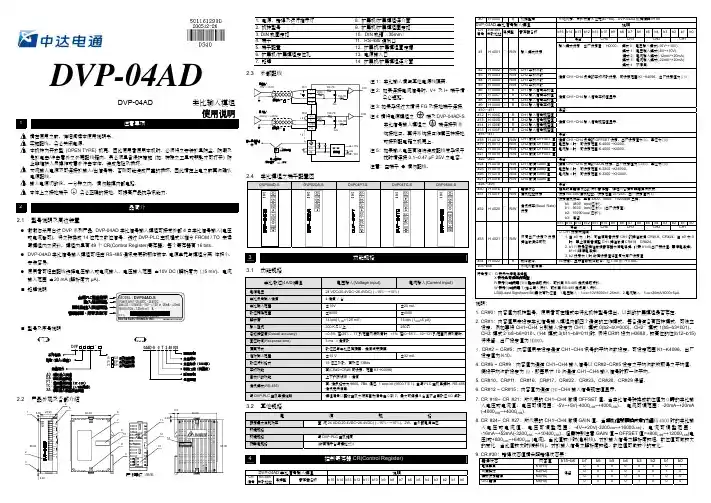
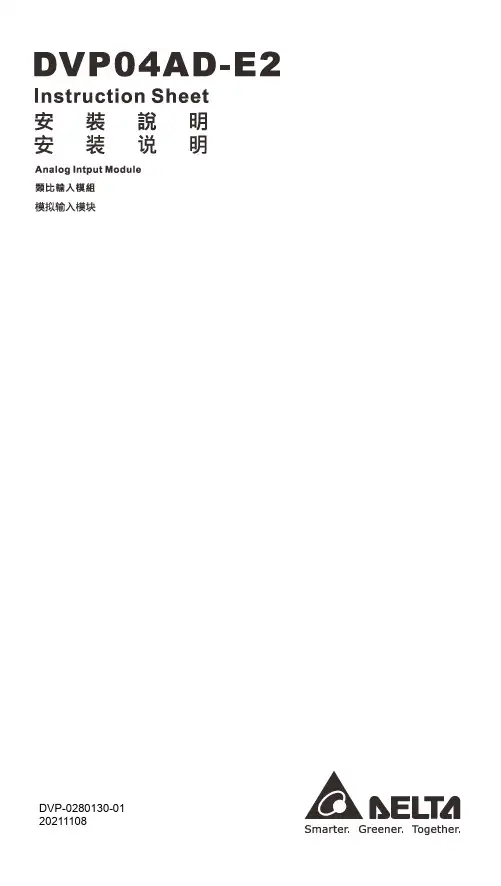
DVP-0280130-01 20211108………………………………………………………………… ENGLISH …………………………………………………………………Thank you for choosing Delta’s DVP series PLC. DVP04AD-E2 analog input module receives external 4 points of analog input signals (voltage or current) and converts them into 16-bit digital signals. You can select voltage input or current input by the wiring. In addition, you can access the data in the module by applying FROM/TO instructions or read the average value of channels directly by using MOV instruction (Please refer to allocation of special registers D9900 ~ D9999).EN DVP04AD-E2 is an OPEN-TYPE device. It should be installed in a control cabinetfree of airborne dust, humidity, electric shock and vibration. To preventnon-maintenance staff from operating DVP04AD-E2, or to prevent an accident from damaging DVP04AD-E2, the control cabinet in which DVP04AD-E2 isinstalled should be equipped with a safeguard. For example, the control cabinet in which DVP04AD-E2 is installed can be unlocked with a special tool or key. EN DO NOT connect AC power to any of I/O terminals, otherwise serious damagemay occur. Please check all wiring again before DVP04AD-E2 is powered up. After DVP04AD-E2 is disconnected, Do NOT touch any terminals in a minute. Make sure that the ground terminal on DVP04AD-E2 is correctly grounded in order to prevent electromagnetic interference.FR DVP04AD-E2 est un module OUVERT. Il doit être installé que dans une enceinteprotectrice (boitier, armoire, etc.) saine, dépourvue de poussière, d’humidité, de vibrations et hors d’atteinte des chocs électriques. La protection doit éviter que les personnes non habilitées à la maintenance puissent accéder à l’appareil (par exemple, une clé ou un outil doivent être nécessaire pour ouvrir a protection). FR Ne pas appliquer la tension secteur sur les bornes d’entrées/Sorties, ou l’appareilDVP04AD-E2 pourra être endommagé. Merci de vérifier encore une fois lecâblage avant la mise sous tension du DVP04AD-E2. Lors de la déconnection de l’appareil, ne pas toucher les connecteurs dans la minute suivante. Vérifier que la terre est bien reliée au connecteur de terre afin d’éviter toute interférence électromagnétique.Product Profile & DimensionUnit:mmExternal WiringNote 1: When performing analog input, please isolate other power wirings.Note 2: When the A/D module is connected to current signals, make sure you short-circuit “V+” and “I+” terminals.Note 3: If the noise is too significant, please connect FE to the grounding terminal.Note 4: Please connect the terminal on both the power module and A/D module to the system earth point and ground the system contact or connect it to the cover of power distribution cabinet. Note 5: If the ripples at the loaded input terminal are too significant that causes noise interference on the wiring, connect the wiring to 0.1 ~ 0.47μF 25V capacitor.I/O Terminal LayoutElectrical SpecificationsAnalog / Digital module (04A/D)Power supply voltage 24VDC (20.4VDC ~ 28.8VDC) (-15% ~ +20%)Analog / Digital module (04A/D)Max. rated powerconsumption1W, supplied by external power sourceConnector European standard removable terminal block (Pin pitch: 5mm)Operation/storage temperature Operation: 0°C~55°C (temp.), 5~95% (humidity), Pollution degree2 Storage: -25°C~70°C (temp.), 5~95% (humidity)Vibration/shock immunity International standards: IEC61131-2, IEC 68-2-6 (TEST Fc)/ IEC61131-2 & IEC 68-2-27 (TEST Ea)Series connection to DVP-PLC MPU The modules are numbered from 0 to 7 automatically by their distance from MPU. Max. 8 modules are allowed to connect to MPU and will not occupy any digital I/O points.Functions SpecificationsAnalog / Digital module Voltage input Current inputAnalog input channel 4 channels / each moduleRange of analog input ±10V ±5V ±20mA 0 ~ 20mA 4 ~ 20mA Range of digitalconversion±32,000 ±32,000 ±32,000 0 ~ 32,000 0 ~ 32,000Max./Min. range of digital data ±32,384 ±32,384 ±32,384 -384~+32,384-384~+32,384Hardware Resolution 14 bits 14 bits 14 bits 13 bits 13 bits Input impedance ≧1MΩ250ΩRange of absolute input ±15V ±32mAOverall accuracy ±0.5% when in full scale (25°C, 77°F)±1% when in full scale within the range of 0 ~ 55°C (32 ~ 131°F)Response time 400μs / each channel Digital data format 2’s complement of 16 bitsAverage function Supported. Available for setting up sampling range in CR#8 ~ CR#11. Range: K1 ~ K100.Self-diagnosis Upper and lower bound detection in all channelsIsolation method Optical coupler isolation between digital circuits and analog circuits. No isolation among analog channels.500VDC between digital circuits and Ground500VDC between analog circuits and Ground500VDC between analog circuits and digital circuits500VDC between 24VDC and GroundControl RegisterCR# Attrib. Register name Explanation#0 O R Model name Set up by the system:DVP04AD-E2 model code = H’0080#1 O R Firmware version Display the current firmware version in hex.#2 O R/W CH1 input mode setting Input mode: Default = H’0000.Take CH1 for example:Mode 0 (H’0000): Voltage input (±10V) Mode 1 (H’0001): Voltage input (±5V)Mode 2 (H’0002): Voltage input (0 ~ +10V) Mode 3 (H’0003): Voltage input (0 ~ +5V) Mode 4 (H’0004): Current input (±20mA) Mode 5 (H’0005): Current input (0 ~ +20mA) Mode 6 (H’0006): Current input (+4~ +20mA) Mode -1 (H’FFFF): Channel 1 unavailable#3 O R/W CH2 input mode setting #4 O R/W CH3 input mode setting #5 O R/W CH4 input mode setting#8 O R/W CH1 sampling range Set sampling range in CH1 ~ CH4: Range = K1 ~ K100 Default = K10#9 O R/W CH2 sampling range #10 O R/W CH3 sampling range #11 O R/W CH4 sampling range #12 X R CH1 average input value Average value of input signals at CH1 ~ CH4#13 X R CH2 average input value #14 X R CH3 average input value #15 X R CH4 average input value #20 X R CH1 present input value Present value of input signals at CH1 ~ CH4#21 X R CH2 present input value #22 X R CH3 present input value #23 X RCH4 present input value#28 O R/W Adjusted Offset value of CH1 Set the adjusted Offset value of CH1 ~ CH4. Default = K0Definition of Offset in DVP04AD-E2:The corresponding voltage (current) input value when the digital output value = 0. #29 O R/W Adjusted Offset value of CH2 #30 O R/W Adjusted Offset value of CH3 #31 O R/W Adjusted Offset value of CH4 #34 O R/W Adjusted Gain value of CH1 Set the adjusted Gain value in CH1 ~ CH4. Default = K16,000Definition of Gain in DVP04AD-E2:The corresponding voltage (current) input value when the digital output value = 16,000.#35 O R/W Adjusted Gain value of CH2 #36 O R/W Adjusted Gain value of CH3 #37 O R/W Adjusted Gain value of CH4Adjusted Offset Value, Adjusted Gain Value:Note1: When using Mode 6 for input, the channel do NOT provide setups for adjusted Offset or Gainvalue. Note2: When input mode changes, the adjusted Offset or Gain value automatically returns to defaults.#40 O R/WFunction: Set value changingprohibited Prohibit set value changing in CH1 ~ CH4.Default= H’0000.#41 X R/WFunction: Save all the setvalues Save all the set values, Default =H’0000 #43 X R Error statusRegister for storing all error status. Refer to table of error status for more information.#100 O R/WFunction: Enable/Disable limitdetectionUpper and lower bound detection, b0~b3corresponds to Ch1~Ch4 (0: Enable/1:Disable). Default= H’0000.#101 X R/W Upper and lower bound statusDisplay the upper and lower bound status (0: Not exceed /1: Exceeds upper or lower bound value), b0~b3 corresponds toCh1~Ch4 for lower bound detection result; b8~b11 corresponds to CH1~CH4 for upper bound detection result. #102 O R/W Set value of CH1 upper boundSet value of CH1~CH4 upper bound. Default = K32000. #103 O R/W Set value of CH2 upper bound #104 O R/W Set value of CH3 upper bound #105 O R/W Set value of CH4 upper bound #108 O R/W Set value of CH1 lower bound Set value of CH1~CH4 lower bound. Default = K-32000.#109 O R/W Set value of CH2 lower bound #110 O R/W Set value of CH3 lower bound#111 O R/W Set value of CH4 lower boundSymbols:O: When CR#41 is set to H’5678, the set value of CR will be saved. X: set value will not be saved.R: able to read data by using FROM instruction. W: able to write data by using TO instruction. ※ CR#43: Error status value. See the table below:Descriptionbit0 K1 (H’1) Power supply error bit6K64 (H’40)CH4 Conversion error bit1 K2 (H’2) Reservedbit9 K512(H’0200)Mode setting errorbit2 K4 (H’4) Upper/lower bound error bit10 K1024(H’0400) Sampling range error bit3 K8 (H’8)CH1 Conversion errorbit11 K2048(H’0800) Upper / lower bound setting error bit4K16 (H’10) CH2 Conversion errorbit12 K4096(H’1000)Set value changing prohibitedbit5 K32 (H’20) CH3 Conversion errorbit13 K8192(H’2000) Communicationbreakdown on nextmoduleNote: Each error status is determined by the corresponding bit (b0 ~ b13) and there may be morethan 2 errors occurring at the same time. 0 = normal; 1 = error※ Module Reset (Available for firmware v1.10 or above): When modules need reset, write H’4352 inCR#0 then disconnect and turn on the power again. The resetting initializes parameter setups to provide normal functions for other modules. Connect to only one module during reset, wait 1 second before disconnecting the power.Explanation on Special Registers D9900~D9999When DVP-ES2 MPU is connected with modules, registers D9900~D9999 will be reserved for storing values from modules. You can apply MOV instruction to operate values in D9900~D9999.When DVP-ES2 MPU is connected with DVP04AD-E2, the configuration of special registers is as below:Module #0Module #1 Module #2 Module #3 Module #4 Module #5 Module #6 Module #7DescriptionD1320 D1321 D1322 D1323 D1324 D1325 D1326 D1327 Model Code D9900 D9910 D9920 D9930 D9940 D9950 D9960 D9970CH1 averageinput value D9901 D9911 D9921 D9931 D9941 D9951 D9961 D9971CH2 averageinput value D9902 D9912 D9922 D9932 D9942 D9952 D9962 D9972CH3 averageinput value D9903 D9913 D9923 D9933 D9943 D9953 D9963 D9973CH4 averageinput value Note 1: D9900 ~ D9999 are average input values of CH1 ~ CH4 and the sampling range is K1 ~ K100.When the sampling range is set to K1, the values displayed in D9900~D9999 are current values. You can use: 1. ES_AIO Configuration Function of WPLSoft or 2. FROM/TO instructions (CR#8 ~ CR#11) to set the sampling range as K1.Adjust A/D Conversion CurveUsers can adjust the conversion curves according to the actual needs by changing the Offset value (CR#28 ~ CR#31) and Gain value (CR#34 ~ CR#37).Gain: The corresponding voltage/current input value when the digital output value = 16,000.Offset: The corresponding voltage/current input value when the digital output value = 0.Equation for voltage input Mode0 / Mode2: 0.3125mV = 20V/64,000 = 10V/32,000()Offset Gain Offset V V X Y -⎪⎪⎭⎫⎝⎛-⨯⨯=320001016000)()(Y=Digital output, X=Voltage input Equation for voltage input Mode1 / Mode3: 0.15625mV = 10V/64,000 = 5V/32,000()Offset Gain Offset V V X Y -⎪⎪⎭⎫ ⎝⎛-⨯⨯=32000516000)()(Y=Digital output, X=Voltage input Equation for current input Mode4 / Mode5: 0.625μA = 40mA/64,000 = 20mA/32,000 ()Offset Gain Offset mA mA X Y -⎪⎪⎭⎫⎝⎛-⨯⨯=320002016000)()(Y=Digital output, X=Current input Equation for current input Mode6: 0.5μA = 16mA/32,000Adopt the Equation of current input Mode4/Mode5, substitute Gain for 19200(12mA) and Offset for 6400 (4mA)()6400192006400320002016000-⎪⎪⎭⎫⎝⎛-⨯⨯=)()(mA mA X YY=Digital output, X=Current inputMode 0:Mode 1:Mode 0 of CR#2 ~ CR#5 -10V ~ +10V ,Gain = 5V (16,000),Offset = 0V (0) Mode 1 of CR#2 ~ CR#5 -5V ~ +5V ,Gain = 2.5V (16,000), Offset = 0V (0) Range of digital conversion -32,000 ~ +32,000 Max./Min. range of digital conversion-32,384 ~ +32,384Mode 2:Mode 3:Mode 4:Mode 4 of CR#2 ~ CR#5-20mA ~ +20mA, Gain = 10mA (16,000), Offset = 0mA (0) Range of digital conversion -32,000 ~ +32,000 Max./Min. range of digital conversion-32,384 ~ +32,384Mode 5:Mode 6:Mode 5 of CR#2 ~ CR#5 0mA ~ +20mA, Gain = 10mA (16,000), Offset = 0mA (0) Mode 6 of CR#2 ~ CR#5 +4mA ~ +20mA, Gain = 12mA (19,200), Offset = 4mA (6,400) Range of digital conversion 0 ~ +32,000 Max./Min. range of digital conversion-384 ~ +32,384……………………………………………………………… 繁體中文 …………………………………………………………………………感謝您採用台達DVP 系列產品。
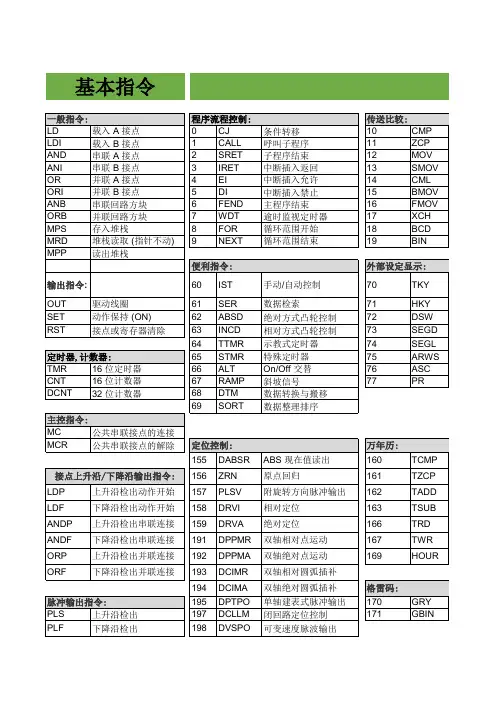
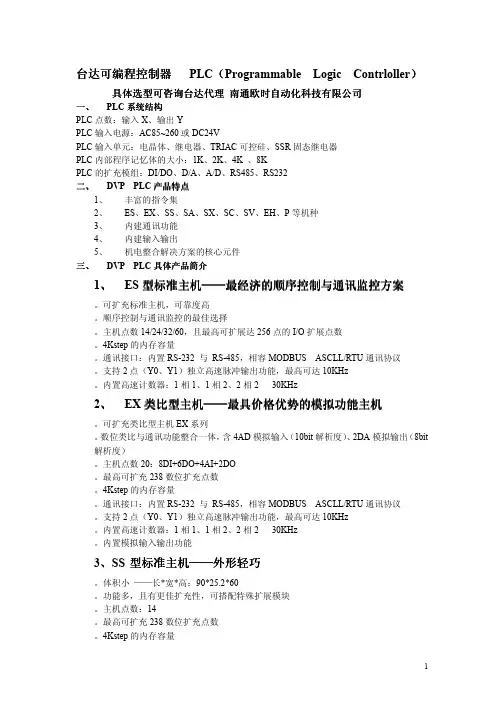
台达可编程控制器 PLC (Programmable Logic Contrloller ) 具体具体选型选型选型可可咨询咨询台达台达台达代理代理 南通南通欧欧时自动化自动化科技科技科技有限有限有限公司公司一、 PLC 系统结构PLC 点数:输入X 、输出YPLC 输入电源:AC85~260或DC24VPLC 输入单元:电晶体、继电器、TRIAC 可控硅、SSR 固态继电器 PLC 内部程序记忆体的大小:1K 、2K 、4K 、8KPLC 的扩充模组:DI/DO 、D/A 、A/D 、RS485、RS232 二、 DVP PLC 产品特点1、 丰富的指令集2、 ES 、EX 、SS 、SA 、SX 、SC 、SV 、EH 、P 等机种3、 内建通讯功能4、 内建输入输出5、 机电整合解决方案的核心元件 三、 DVP PLC 具体产品简介1、 ES 型标准主机型标准主机——————最经济的顺序控制与通讯监控方案最经济的顺序控制与通讯监控方案。
可扩充标准主机,可靠度高 。
顺序控制与通讯监控的最佳选择。
主机点数14/24/32/60,且最高可扩展达256点的I/O 扩展点数 。
4Kstep 的内存容量。
通讯接口:内置RS-232 与 RS-485,相容MODBUS ASCLL/RTU 通讯协议 。
支持2点(Y0、Y1)独立高速脉冲输出功能,最高可达10KHz 。
内置高速计数器:1相1、1相2、2相2 30KHz2、 EX 类比型主机类比型主机——————最具价格优势最具价格优势最具价格优势的模拟功能主机的模拟功能主机。
可扩充类比型主机EX 系列 。
数位类比与通讯功能整合一体,含4AD 模拟输入(10bit 解析度)、2DA 模拟输出(8bit 解析度)。
主机点数20:8DI+6DO+4AI+2DO 。
最高可扩充238数位扩充点数 。
4Kstep 的内存容量。
通讯接口:内置RS-232 与 RS-485,相容MODBUS ASCLL/RTU 通讯协议 。

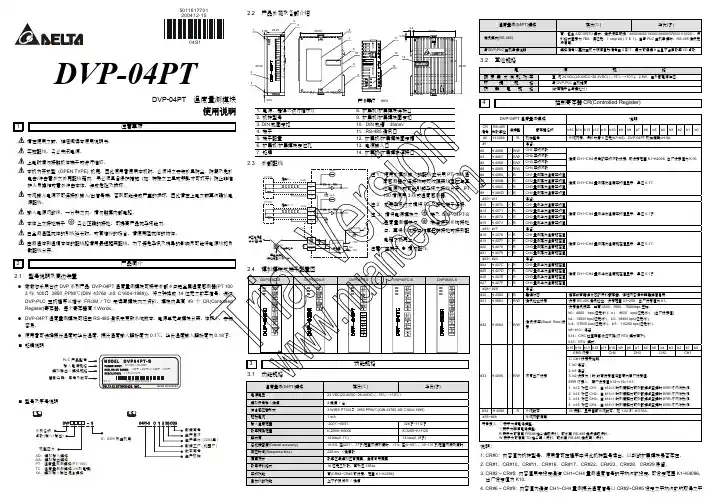
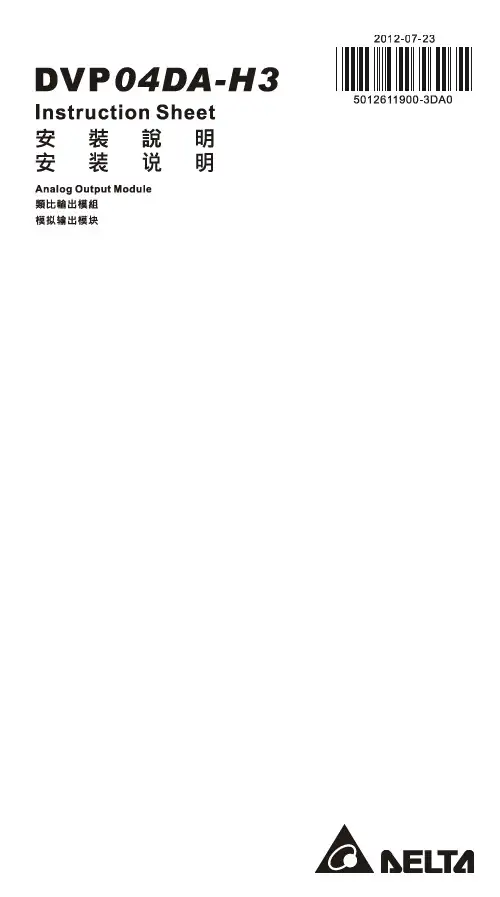
………………………………………………………………… ENGLISH …………………………………………………………………Thank you for choosing the Delta DVP series PLC. Four channels on DVP04DA-H3 are able to receive four pieces of 16-bit digital data from a CPU module, and convert them into analog signals (voltages or currents). Users can read data from the module or write data into the module by means of the instruction FROM/TO in a DVP-EH2 series PLC. There are 49 control registers in the module, and they are 16-bit registers. Whether the output signals are voltage outputs or current outputs depends on the wiring. The voltage output range is ±10VDC. (The resolution is 312.5μV.) The current output range is 0~20 mA. (The resolution is 0.625μA).a Please read this instruction sheet carefully before using the product.a Switch off the power supply before wiring. Please do not touch the internal circuit untilthe power supply has been switched off for one minute.a DVP04DA-H3 is an OPEN-TYPE device. It should be installed in a control cabinetfree of airborne dust, humidity, electric shock and vibration. To prevent thenon-maintenance staff from operating the product, or to prevent an accident from damaging the product, the control cabinet should be equipped with a safeguard. For example, the control cabinet is unlocked with a special tool or key.a DO NOT connect the input AC power supply to any of I/O terminals; otherwiseserious damage may occur. Check all the wiring again before switching on the power supply. Do NOT touch any terminals when the power supply is switched on.a Make sure that the ground terminal is correctly grounded in order to preventelectromagnetic interference.Product Profile & DimensionsUnit: mm1. Groove (35 mm) 6.Terminals2. Connector 7.Mounting hole3. Model name 8.Arrangement of I/O terminals4. POWER, ERROR, and D/A LED indicators9.Connector5. Mounting holeI/O Terminal LayoutExternal Wiringa reIt is*1. Please isolate the analog output from other power cables.*2. If the ripple is large for the input terminal of the load and results in the noise interference with the wiring, please connect the module to the capacitor having a capacitance within the range between 0.1μF and 0.47μF with a working voltage of 25V.*3. Please connect the terminal on a CPU module and the terminal on DVP04DA-H3 toa system ground, and then ground the system ground, or connect it to a distribution box.SpecificationsDigital-to-analog module Voltage output Current outputSupply voltage 24VDC (20.4VDC~28.8VDC) (-15%~+20%)Number of channels 4 channelsAnalog output range -10V~+10V 0~20mA Digital data range -32,000~+32,000 0~32,000 Resolution 16 bits (312.5μV) 15 bits (0.625μA)Input impedance 0.5 Ω or belowOverall accuracy 25°C/77°F: ±0.5% of the input within the range0~55°C/32~131°F: ±1% of the input within the rangeResponse time 1msMaximum outputcurrent10mA -Permissible loadimpedance-0~500ΩData format Two’s complement (16-bit data)Isolation The internal circuit is isolated from the analog outputs by an optocoupler, and the analog channels are not isolated from one another.Protection The voltage output is equipped with the short circuit protection. However, users must notice that a long-term short circuit will damage the internal circuit. The current output can be an open circuit.Digital-to-analog module Voltage output Current outputCommunication mode (RS-485) ASCII/RTU modeCommunication speed: 4,800/9,600/19,200/38,400/57,600/115,200 bpsASCII data: 7-bit, even bit, 1 stop bit (7, E, 1)RTU data: 8-bit, even bit, 1 stop bit (8, E, 1)When DVP04DA-H3 is connected to a CPU module, the RS-485 communication can not be used.Connection with a DVP-PLC CPU The modules are numbered according to their distances from the CPU module. The numbers start from 0 to 7. Eight modules at most can be connected, and they do not occupy digital inputs/outputs.Other SpecificationsPower specificationsRated maximum power consumption 24VDC (20.4VDC~28.8VDC) (-15% ~ +20%); 4.5W An external power supply supplies the DC voltage.Environment specificationsOperation/Storage Operation: 0°C~55°C (temperature); 50~95% (humidity); pollution degree 2Storage: -25°C~ 70°C (temperature), 5~95% (humidity)Vibration/Shock resistance International standards IEC 61131-2, IEC 68-2-6 (TEST Fc)/IEC 61131-2 & IEC 68-2-27 (TEST Ea)Control RegisterCR# ParameteraddressAttribute Register name Description#0 H’5032 O R Model The model is defined by the system. The modelof DVP04DA-H3 is H’6408.Users can read the model from the register by means of the program.b15 ~ b12b11 ~ b8B7 ~ b4 b3 ~ b0 CH4 CH3 CH2 CH1#1 H’5033 O R/W Output modes Mode 0000: Voltage output (-10 V~+10V) Mode 0001: Voltage output (-5 V~+5 V) Mode 0010: Voltage output (1 V~+5 V) Mode 0011: Current output (4 mA~+20 mA) Mode 0100: Current output (0 mA~+20 mA) Mode 1111: The channel is disabled.CR#1: The value in the register represents the working modes of the four channels. If CH1 is in mode 0 (b3~b0=0000), CH2 is in mode 1 (b7~b4=0001), CH3 is in mode 2 (b11~b8=0010), and CH4 is in mode 3 (b15~b12=0011), the value in CR#1 is H’3210. The default value in the register is H’0000.#2 H’5038 X R/W Value sent by CH1#3 H’5039 X R/W Value sent by CH2#4 H’503A X R/W Value sent by CH3#5 H’503B X R/W Value sent byCH4Values sent by CH1~CH4 are stored in theseregisters.Range: K-32000~K32000Default: K0Unit: LSB#6 H’5044 O R/W Offset used for calibrating the signal sent by CH1#7 H’5045 O R/W Offset used for calibrating the signal sent by CH2#8 H’5046 O R/W Offset used for calibrating the signal sent by CH3#9 H’5047 O R/W Offset used forcalibrating thesignal sent byCH4Users can store the offsets in these registers.Default: K0Unit: LSB#12 H’504A O R/W Gain used for calibrating the signal sent by CH1#13 H’504B O R/W Gain used for calibrating the signal sent by CH2#14 H’504C O R/W Gain used for calibrating the signal sent by CH3#15 H’504D O R/W Gain used forcalibrating thesignal sent byCH4Users can store the gains in these registers.Default: K16,000Unit: LSB#30 H’5050 X R Errorstate The error state is stored in this register. Please refer to error message table below.#31 H’5051 O R/W CommunicationaddressThe RS-485 communication address is stored inthis register. The setting range is 01 ~ 254. Thedefault value is K1.#32 H’5052 O R/W CommunicationspeedCommunication speed:4,800/9,600/19,200/38,400/57,600/115,200 bpsASCII data: 7-bit, even bit, 1 stop bit (7, E, 1)RTU data: 8-bit, even bit, 1 stop bit (8, E, 1)Default: H’0002b0: 4,800 bps; b1: 9,600 bps (default)b2: 19,200 bps; b3: 38,400 bpsb4: 57,600 bps; b5: 115,200 bps (bits/second)b6~b13: Reservedb14: The high byte of the CRC checksum isinterchanged with the low byte of the CRCchecksum. (Only the RTU mode supportsthe interchange.)b15: Switch between the ASCII mode and theRTU mode (0: ASCII mode (default))b15 ~ b12b11~b9b8~b6 b5~b3 b2~b0Reserved CH4 CH3 CH2 CH1#33 H’5053 O R/W Restoring allthe settingvalues to thefactory settingThe default value is H’0000. Take CH1 forexample. If the value of b2 is 1, all the settingvalues are restored to the factory setting.#34 H’5054 O R FirmwareversionThe current version of the firmware isrepresented by a hexadecimal number. Forexample, if the current version of the firmware is1.0A, it is represented by H’010A.#35 ~ #48 For system use onlyThe definitions of the symbols:O indicates that the register is a latched register. (Data needs to be written into the register through the RS-485 communication.) X indicates that the register is a non-latched register. R indicates that the data can be read from the register by means of the instruction FROM or through the RS-485 communication.W indicates that the data can be written into the register by means of the instruction TO or through the RS-485 communication.Least significant bit (LSB): 1. Voltage output: 1LSB=10 V/32,000=0.3125 mV2. Current output: 1 LSB=20 mA/32,000=0.625 μA※ Error state tableError state Value b15 ~ b8 b7b6b5b4 b3 b2 b1 b0The power supply is abnormal. K1(H’1) 0000 0 0 0 1Hardware failure (GPIO) K2(H’2) 0000 0 0 1 0Offset/Gain error K8 (H’8) Reserved0000 1 0 0 0Note: Every error state depends on the value of a corresponding bit. There may more than two error states at the same time. If the value of a bit is 0, there is no error. If the value of a bit is 1, there is an error.CR#0~CR#34: Their corresponding parameter addresses are H’5032~H’5054. Users can read/write data through the RS-485 communication. When users use the RS-485 communication, they must separate the module from the CPU module.1. They support the communication speed 4,800/9,600/19,200/38,400/57,600/115,200bps.2. Users can use the Modbus ASCII/RTU mode.ASCII data: 7-bit, even bit, 1 stop bit (7, E, 1)RTU data: 8-bit, even bit, 1 stop bit (8, E, 1)3. Function code:H’03: Reading the data from the registerH’06: Writing the data into the registerH’10: Writing the data into several registers.4. If the register is a latched register, users need to write the data into the registerthrough the RS-485 communication. If users write the data into the latched register by means of the instruction TO/DTO, the data is not retained when there is power failure.Adjust Conversion CurveUsers can adjust the conversion curves according to the practical application by changing the offset values (stored in CR#6~CR#9) and the gain values (stored inCR#12~CR#15).Gain: The corresponding voltage/current input value when the digital output value = 16,000.Offset: The corresponding voltage/current input value when the digital output value = 0.y Equation for voltage output Mode0: 0.3125mV = 20V/64,000()()⎟⎠⎞⎜⎝⎛×⎥⎦⎤⎢⎣⎡+−×=32000)(1016000V Offset Offset Gain X V YY=Voltage output, X=Digital inputy Equation for current output Mode1: 0.625μA = 20mA/32,000()()⎟⎠⎞⎜⎝⎛×⎥⎦⎤⎢⎣⎡+−×=32000)(2016000mA Offset Offset Gain X mA YY=Current output, X=Digital inputy Equation for current output Mode2: 0.5μA = 16mA/32,000Adopt the equation of current output mode 1, substitute Gain for 19,200(12mA) andOffset for 6,400(4mA)()()⎟⎠⎞⎜⎝⎛×⎥⎦⎤⎢⎣⎡+−×=32000)(20640016000640019200mA X mA YY=Current output, X=Digital inputy Mode 0:y Mode 1:Mode 0 (CR#1) -10V~+10V; Gain=5V (16,000),Offset = 0V (0) Mode 1 (CR#1) -5V~+5V; Gain=2.5V (16,000),Offset = 0V (0) Range of digital values-32,000~+32,000y Mode 2:y Mode 3:Volt ag e ou tp utC urren t ou tp uty Mode 4:Mode 2 (CR#1) 1V~+5V; Gain=3V; Offset=1VMode 3 (CR#1) +4mA~+20mA; Gain=12mA (19,200); Offset=4mA (6,400) Mode 4 (CR#1) 0mA~+20mA; Gain=10mA (16,000); Offset=0V (0) Range of digital values 0~+32,000……………………………………………………………… 繁體中文 …………………………………………………………………………感謝您採用台達DVP系列產品。
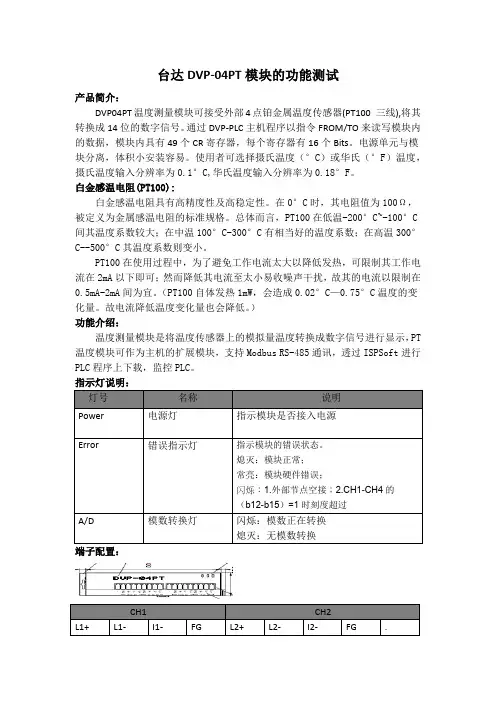
台达DVP-04PT模块的功能测试产品简介:DVP04PT温度测量模块可接受外部4点铂金属温度传感器(PT100 三线),将其转换成14位的数字信号。
通过DVP-PLC主机程序以指令FROM/TO来读写模块内的数据,模块内具有49个CR寄存器,每个寄存器有16个Bits。
电源单元与模块分离,体积小安装容易。
使用者可选择摄氏温度(°C)或华氏(°F)温度,摄氏温度输入分辨率为0.1°C,华氏温度输入分辨率为0.18°F。
白金感温电阻(PT100):白金感温电阻具有高精度性及高稳定性。
在0°C时,其电阻值为100Ω,被定义为金属感温电阻的标准规格。
总体而言,PT100在低温-200°C~-100°C 间其温度系数较大;在中温100°C-300°C有相当好的温度系数;在高温300°C--500°C其温度系数则变小。
PT100在使用过程中,为了避免工作电流太大以降低发热,可限制其工作电流在2mA以下即可;然而降低其电流至太小易收噪声干扰,故其的电流以限制在0.5mA-2mA间为宜。
(PT100自体发热1mW,会造成0.02°C—0.75°C温度的变化量。
故电流降低温度变化量也会降低。
)功能介绍:温度测量模块是将温度传感器上的模拟量温度转换成数字信号进行显示,PT 温度模块可作为主机的扩展模块,支持Modbus RS-485通讯,透过ISPSoft进行PLC程序上下载,监控PLC。
指示灯说明:端子配置:CH1 CH2控制要求:通过DVP-PT模块将PT100感受到的温度转换成数字格式的输出系统结构:操作步骤:A)硬件配置步骤Step1:将dvp04pt-s与主机dvp28sv11r的扩展口相连;人机DOP-BO7PS515的COM2与主机28sv的RS-485相连;PT100(三线)分别连接到04PT的CH1-CH4通道(PT100接线如下图所示)设置人机的通讯为RS-485(如下图)B)程序编写D10-D13 CH1-CH4摄氏温度平均值D20-D23 CH1-CH4 华氏温度平均值D30-D33 CH1-CH4摄氏温度现在值D40-D43 CH1-CH4华氏温度现在值M0 恢复出厂值Step1:HMI程序编写,在画面1中建立8组数值显示元件(如下图),分别对应CH1-CH4通道的摄氏温度平均值&华氏温度平均值。
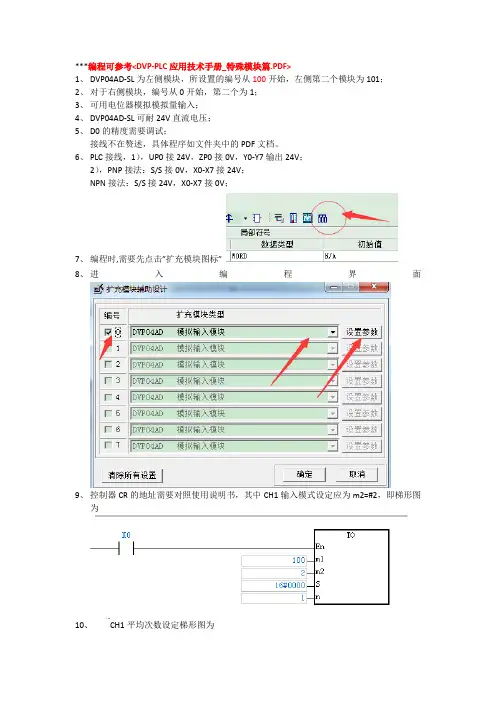
***编程可参考<DVP-PLC应用技术手册_特殊模块篇.PDF>
1、DVP04AD-SL为左侧模块,所设置的编号从100开始,左侧第二个模块为101;
2、对于右侧模块,编号从0开始,第二个为1;
3、可用电位器模拟模拟量输入;
4、DVP04AD-SL可耐24V直流电压;
5、D0的精度需要调试;
接线不在赘述,具体程序如文件夹中的PDF文档。
6、PLC接线,1),UP0接24V,ZP0接0V,Y0-Y7输出24V;
2),PNP接法:S/S接0V,X0-X7接24V;
NPN接法:S/S接24V,X0-X7接0V;
7、编程时,需要先点击”扩充模块图标”
8、进入编程界面
9、控制器CR的地址需要对照使用说明书,其中CH1输入模式设定应为m2=#2,即梯形图
为
10、CH1平均次数设定梯形图为
11、CH1输入信号平均值为
12、CH1输入信号现在值为:
13、DVP04AD-SL接线方式为:相当于电压表,V1+接正极,V1-接负极,FG接屏蔽线;
若为电流输入,V1+与I1+短接,再接入,相当于电流表
1)V1+接电位器+极,V1-接电位器负极,并联在两端,相当于电压表测电压。
14、整个电路图如下图所示
15、
16、。
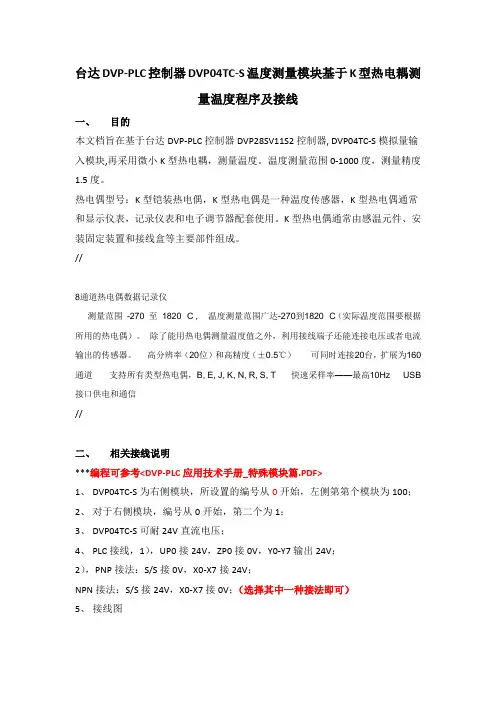
台达DVP-PLC控制器DVP04TC-S温度测量模块基于K型热电耦测量温度程序及接线一、目的本文档旨在基于台达DVP-PLC控制器DVP28SV11S2控制器, DVP04TC-S模拟量输入模块,再采用微小K型热电耦,测量温度。
温度测量范围0-1000度,测量精度1.5度。
热电偶型号:K型铠装热电偶,K型热电偶是一种温度传感器,K型热电偶通常和显示仪表,记录仪表和电子调节器配套使用。
K型热电偶通常由感温元件、安装固定装置和接线盒等主要部件组成。
//8通道热电偶数据记录仪测量范围-270 至1820 °C ,温度测量范围广达-270到1820 °C(实际温度范围要根据所用的热电偶)。
除了能用热电偶测量温度值之外,利用接线端子还能连接电压或者电流输出的传感器。
高分辨率(20位)和高精度(±0.5℃)可同时连接20台,扩展为160通道支持所有类型热电偶,B, E, J, K, N, R, S, T 快速采样率——最高10Hz USB 接口供电和通信//二、相关接线说明***编程可参考<DVP-PLC应用技术手册_特殊模块篇.PDF>1、DVP04TC-S为右侧模块,所设置的编号从0开始,左侧第第个模块为100;2、对于右侧模块,编号从0开始,第二个为1;3、DVP04TC-S可耐24V直流电压;4、PLC接线,1),UP0接24V,ZP0接0V,Y0-Y7输出24V;2),PNP接法:S/S接0V,X0-X7接24V;NPN接法:S/S接24V,X0-X7接0V;(选择其中一种接法即可)5、接线图接线图6、DVP04TC-S接线,先接上”+””_”24V电压及零线;本测量使用4路测量,CH1, DVP04TC-S接线方式为:L+接热电偶正极,L-接热电偶负极。
三、编程说明***编程可参考<DVP-PLC应用技术手册_特殊模块篇.PDF>1、DVP04TC-S为右侧模块,所设置的编号从0开始,第二个模块为1;2、对于右侧模块,编号从0开始,第二个为1;3、编程时,需要先点击”扩充模块图标”4、5、进入编程界面6、7、控制器CR的地址需要对照使用说明书,其中CH1输入模式设定应为m1=#1,即梯形图为,设置输入模式,16#249表示设置CH1\CH2\CH3\CH4均为K型热电偶输入。
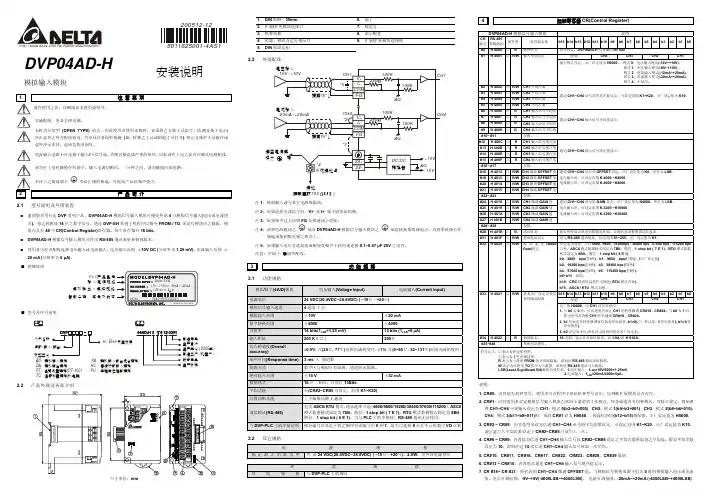
14应用指令简单定位设计范例14.1 台达ASDA伺服简单定位演示系统X1伺服电机Y0脉冲输出Y1正转反转/Y4脉冲清除DOP-A人机ASDA伺服驱动器WPLSoft【控制要求】z由台达PLC和台达伺服组成一个简单的定位控制演示系统。
通过PLC发送脉冲控制伺服,实现原点回归、相对定位和绝对定位功能的演示。
z监控画面:原点回归、相对定位、绝对定位。
【元件说明】PLC软元件说明M0 原点回归开关M1 正转10圈开关M2 反转10圈开关M3 坐标400000开关M4 坐标-50000开关M10 伺服启动开关M11 伺服异常复位开关M12 暂停输出开关(PLC脉冲暂停输出)M13 伺服紧急停止开关X0 正转极限传感器X1 反转极限传感器X2 DOG(近点)信号传感器X3 来自伺服的启动准备完毕信号(对应M20)X4 来自伺服的零速度检出信号(对应M21)X5 来自伺服的原点回归完成信号(对应M22)X6 来自伺服的目标位置到达信号(对应M23)X7 来自伺服的异常报警信号(对应M24)Y0 脉冲信号输出14应用指令简单定位设计范例Y1 伺服电机旋转方向信号输出Y4 清除伺服脉冲计数寄存器信号Y6 伺服启动信号Y7 伺服异常复位信号Y10 伺服电机正方向运转禁止信号Y11 伺服电机反方向运转禁止信号Y12 伺服紧急停止信号M20 伺服启动完毕状态M21 伺服零速度状态M22 伺服原点回归完成状态M23 伺服目标位置到达状态M24 伺服异常报警状态【ASD-A伺服驱动器参数必要设置】参数设置值说明P0-02 2伺服面板显示脉冲指令脉冲计数P1-00 2外部脉冲输入形式设置为脉冲+方向P1-01 0位置控制模式(命令由外部端子输入)P2-10 101当DI1=On时,伺服启动P2-11 104当DI2=On时,清除脉冲计数寄存器P2-12 102当DI3=On时,对伺服进行异常重置P2-13 122当DI4=On时,禁止伺服电机正方向运转P2-14 123当DI5=On时,禁止伺服电机反方向运转P2-15 121当DI6=On时,伺服电机紧急停止P2-16 0无功能P2-17 0无功能P2-18 101当伺服启动准备完毕,DO1=OnP2-19 103当伺服电机转速为零时,DO2=OnP2-20 109当伺服完成原点回归后,DO3=OnP2-21 105当伺服到达目标位置后,DO4=OnP2-22 107当伺服报警时,DO5=OnÚ当出现伺服因参数设置错乱而导致不能正常运行时,可先设置P2-08=10(回归出厂值),重新上电后再按照上表进行参数设置。
台达DVP-PLC控制器DVP04AD-SL模拟量输入模块测量温度程序及接线一、目的本文档旨在基于台达DVP-PLC控制器DVP28SV11S2控制器, DVP04AD-SL模拟量输入模块,在采用小型PT100铂电阻,测量温度.二、相关接线说明***编程可参考<DVP-PLC应用技术手册_特殊模块篇.PDF>1、DVP04AD-SL为左侧模块,所设置的编号从100开始,左侧第二个模块为101;2、对于右侧模块,编号从0开始,第二个为1;3、DVP04AD-SL可耐24V直流电压;4、PLC接线,1),UP0接24V,ZP0接0V,Y0-Y7输出24V;2),PNP接法:S/S接0V,X0-X7接24V;NPN接法:S/S接24V,X0-X7接0V;5、24V-1K欧-1K欧-PT100”+”-PT100”-”-0V接线图6、DVP04AD-SL接线,先接上”+””_”24V电压及零线;本测量仅使用1路测量,CH1, DVP04AD-SL接线方式为:相当于电压表,V1+接正极,V1-接负极,FG接屏蔽线;若为电流输入,V1+与I1+短接,再接入,相当于电流表1)V1+接电位器+极,V1-接电位器负极,并联在两端,相当于电压表测电压。
三、编程说明***编程可参考<DVP-PLC应用技术手册_特殊模块篇.PDF>1、DVP04AD-SL为左侧模块,所设置的编号从100开始,左侧第二个模块为101;2、对于右侧模块,编号从0开始,第二个为1;3、编程时,需要先点击”扩充模块图标”4、5、进入编程界面6、7、控制器CR的地址需要对照使用说明书,其中CH1输入模式设定应为m2=#2,即梯形图为,设置输入模式8、CH1平均次数梯形图为,3200存入D809、测量开始控制,X1接通,M1接通,开始读取相关通道数据10、CH1输入信号平均值为11、CH1输入信号现在值为:12、浮点数转换,平均值D40转换成浮点数,放入D60, 现在值D50转换成浮点数,放入D70, D80寄存器中的3200转换成浮点数,放入D20.13、平均值转换成实际电压14、现在值转换成实际电压15、X2重置测量,四、PT100铂电阻温度读数本测试系统,基于PT100铂电阻传感器,在PLC程序中,只能通过D0读取铂电阻两端的电压现在值,通过D6读取铂电阻两端的电压平均值,比如读数为1.447V,通过换算,可得出PT100此时的电阻值为128.3199574Ω,通过””PT100分度表””可查的此时的温度约为73.5℃.。
DVP-PLC特殊模块怎么使用DVP-PLC特殊模块怎么使用?成都永浩机电工程技术有限公司做了以下总结供大家参考:一、模拟输入模块DVP04AD/DVP06AD在自动化的领域中,有许多的测量单元,是以模拟信号的模式进行传送的动作,且以电压-10~10V 与电流-20~20mA 范围最为常见。
若要将模拟信号作为PLC 控制演算的参数,则需转换为数字量。
例如:电压-10~10V。
经由AD 模块的转换成为-8,000~+8,000 的数值范围后,PLC 再以FROM/TO 指令对AD 模块的CR 寄存器进行读写的动作,所传回至PLC 的信号为K-8,000~ K8,000 的数字量,即可提供PLC 进行运算处理。
DVP04AD (DVP06AD)模拟信号输入模块可接受外部4 (6)点模拟信号输入(电压或电流皆可),并将其转换成14 位的数字信号。
通过主机以指令FROM/TO 来读写模块内的数据,摸块内具有49 个CR (Control Register)寄存器,每个寄存器为16bits。
可经由配线选择电压输入或电流输入。
电压输入范围±10V (±8,000,分辨率为。
电流输入范围±20mA (±4,000,分辨率为5μA)。
二、模拟输出模块DVP02DA/DVP04DA在应用的领域中,有许多的控制信号,是以模拟信号的模式进行控制,且以0~10V 与0~20mA范围为最常见的信号范围。
因此需将PLC 数值数据转换为模拟信号来控制周边装置。
例如:PLC 数值数据0~4,000 的范围。
经由DA 模块的转换成为0~10V 的电压值,所输出的电压即可提供周边模拟装置进行控制。
DVP02DA (DVP04DA) 模拟信号输出模块,可通过DVP-PLC 主机程序以指令FROM/TO 来读写DVP02DA (DVP04DA) 模拟信号输出模块的数据。
模块内具有49 个CR (Control Register) 寄存器,每个寄存器有16bits。
台达PLC各列的功能说明台达PLC各系列的功能说明台达PLC主要包括:E系列主机;S系列主机;新增主机PM主机和SV主机。
一,E系列主机包括:EX;ES;EH21,EH2系列:优异的运算功能,内置庞大的程序与资料存储空间,支持超过200个应用指令,新增2轴直线/圆弧插补运动控制功能,并可搭配多样化的高速特殊扩充模块与功能卡,可满足各式各样要求及时反应的应用.1)主机点数:16/20/32/40/48/64/80 2)最大I/O点数:512点3)内存容量:16K Steps 4)运算执行速度:0.24us(基本指令)5)通讯接口:内置RS-232与RS-485,相容MODBUS ASCII/RTU 通讯协议,可扩充第3个通讯端口(弹性扩展功能卡;型号:DVP-F232S和DVP-F485S。
6)资料存储器:10,000字节7)档案存储器: 10,000字节该系列应用:1):200khz高速计数器和内置独立200khz脉冲输出功能(提供伺服定位指令)。
PLC机型:DVP20EH00T和DVP32EH00T;DVP40EH00R2/T2 20/32点主机支持2点200khz(Y0,Y2);40点主机支持2组AB相200khz脉冲输出(Y0,Y1)(Y2,Y3)和2点200khz脉冲输出(Y4,Y6)。
2):可连接8台模拟,温度,定位,计数器等扩展模块PID,PLC Easy Link(32站),有187条应用指令。
3):该系列支持数字,模拟,通讯,内存功能卡与资料设定器等功能。
4):内置4组硬件高速计数器,1):1相1:组数(6)频宽(10Khz)(一般型)2):1相1:组数(2/2)频宽(200khz/20Khz)3):1相2:组数(2/2)频宽(200khz/20Khz)4):2相2:组数(2/2)频宽(200khz/20Khz)5):优异的运算能力:CPU+ASIC双处理器,支持浮点运算。
6):直线/圆弧补间运动功能支持最新开发的直线/圆弧插补运动控制指令,搭配高速脉冲输出功能,可以轻易达到两轴同时动作的控制要求。
台达D V P_P L C用电位器的电
压模拟传感器D V P04A D_S L
模拟量输入成功程序(总1页) -CAL-FENGHAI.-(YICAI)-Company One1
-CAL-本页仅作为文档封面,使用请直接删除
***编程可参考<DVP-PLC应用技术手册_特殊模块篇.PDF>
1、DVP04AD-SL为左侧模块,所设置的编号从100开始,左侧第二个模块为101;
2、对于右侧模块,编号从0开始,第二个为1;
3、可用电位器模拟模拟量输入;
4、DVP04AD-SL可耐24V直流电压;
5、D0的精度需要调试;
接线不在赘述,具体程序如文件夹中的PDF文档。
6、PLC接线,1),UP0接24V,ZP0接0V,Y0-Y7输出24V;
2),PNP接法:S/S接0V,X0-X7接24V;
NPN接法:S/S接24V,X0-X7接0V;
7、编程时,需要先点击”扩充模块图标”
8、进入编程界面
9、控制器CR的地址需要对照使用说明书,其中CH1输入模式设定应为m2=#2,即梯形图为
10、CH1平均次数设定梯形图为
11、CH1输入信号平均值为
12、CH1输入信号现在值为:
13、DVP04AD-SL接线方式为:相当于电压表,V1+接正极,V1-接负极,FG接屏蔽线;若为电流输入,V1+
与I1+短接,再接入,相当于电流表
1)V1+接电位器+极,V1-接电位器负极,并联在两端,相当于电压表测电压。
14、整个电路图如下图所示
2。